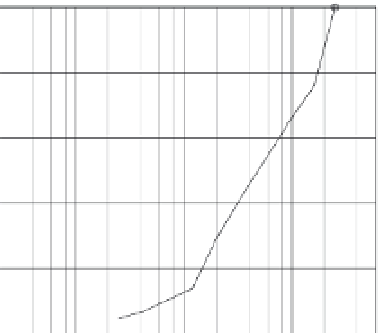Environmental Engineering Reference
In-Depth Information
static liquefaction (Boldini
et al
. 2009). Further
tests, presented in this paper, were conducted
at DPRi of kyoto University using different
drainage and shearing conditions, measuring
void ratio and grain size changes. The aim is to
link shear failure to the evolution of state param-
eters and soil texture within the shear zones, in the
perspective of defining mode of slope evolution
leading to failure.
of scoriaceous lava (autoclastic breccia) having the
same porosity of the grains (Rotonda
et al
. 2010).
This material, taken at the lava flow fronts, repre-
sents a major source for the productions of volcani-
clastic grains. The uniaxial compressive strength
and the tensile strength from Brazil tests, deter-
mined on cylindrical specimens 42 mm in diameter,
are characterised by a mean value of 34.5 MPa and
4.01 MPa respectively which account for crushing at
moderate stresses.
2
The MaTeRial
3
PReVioUs TesTs
The material used in all tests comes from layers
of sandy gravels (curve a in
Fig. 1
) sampled from
horizons of the volcaniclastic sequence outcrop-
ping at the foot of the sciara slope. To ensure a con-
venient ratio between the maximum grain size and
the minimum specimen dimension, tests were per-
formed on the fractions passing the 8 mm sieve.
Therefore the in situ grain size distribution curve
was shifted parallel to the grain size axis obtain-
ing a reference soil (curve sG in
Fig. 1
) classified
as sand and gravel, with uniformity coefficient of
9.6. in situ void ratio, calculated from the in-situ
density of a volcaniclastic layer with a particle size
distribution similar to that of the material used in
laboratory tests, is 0.83.
Grains are mostly basaltic scoriae and scoria
fragments with high roughness and low sphericity.
average porosity, created by widespread pores often
tortuous, is 17.5%. Previous tests (Tommasi
et al
.
2005) indicate that grains exhibit relevant crushing
occurring as collapse and rupture of surface asperi-
ties. This behaviour induced to evaluate the strength
of the grains, which was investigated through stand-
ard tests on cylindrical specimens cored from blocks
Results of a first set of tests performed using the
large-scale ring-shear apparatus DPRi-6, devel-
oped at the DPRi, kyoto University (sassa 1997)
are described in detail by Boldini
et al
. (2009). The
DPRi-6 device is characterised by an inner diam-
eter of 250 mm, an outer diameter of 350 mm and
a maximum sample height of 150 mm.
Tests can be conducted in both drained and
undrained conditions, thanks to a water-leakage
tightness system formed by o-rings on the upper
loading platen, and bonding rubber edges on
the two confining rings of the lower rotary pair
(sassa
et al
. 2004). Pore pressure is measured by
two transducers located 2 mm above the shear
surface.
all the specimens were prepared using the dry
pluviation method with the aim of obtaining a very
loose initial configuration, similar to that produced
by the deposition process at sciara del Fuoco. in
all tests, saturation was obtained by exposing the
sample to a co
2
flux followed by a de-aired water
flux for a time (generally more than 12 hours) suf-
ficient to obtain a value of skempton's pore pres-
sure parameter
B
higher than 0.95.
Torque-controlled tests were performed in
undrained conditions and with free drainage at
the sample top. During the latter procedure excess
pore pressure can generate depending on material
behaviour and loading rate.
in both cases, samples were consolidated at a
normal stress of 230 kPa and a shear stress of
122 kPa. These values, calculated assuming that
the material is normally consolidated (Boldini
et al 2009), correspond to the lithostatic stresses
along the reconstructed slip surface of the sub-
marine slide, located at the average depth and
dip of 37 m and 28°, respectively. at the end
of consolidation, the dry unit weight ranged
between 16.6 and 17.2 kn/m
3
. The shearing stage
was carried out by applying a shear torque with a
loading rate of 55 Pa/s.
in undrained tests, the volcaniclastic mate-
rial experienced liquefaction, evidenced by an
abrupt increase in pore-water pressure up to values
100
80
60
SG (tested material)
40
A (in situ soil)
20
0
0.1
1
10
grain size (mm)
Figure 1. Particle-size distribution curves of the in situ
volcaniclastic soil (curve a) and tested material (sG).




































